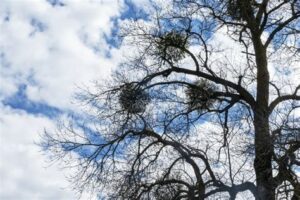

Southern Mistletoe (Phoradendron leucarpum) is a species of mistletoe native to the southeastern United States, though it can be found in other parts of the country as well. Like other mistletoe species, Southern Mistletoe is a parasitic plant that attaches itself to the branches of trees and shrubs, growing it’s “Root System” into the Tree itself. Stealing nutrients and water from its host plant. (usually an Elm) It has a distinctive appearance with leathery, evergreen leaves and small white berries. It weakens and eventually kills the Tree in sections.
Characteristics:
- Leaves: The leaves of Southern Mistletoe are thick, leathery, and dark green. They are typically elliptical in shape and grow in pairs or clusters along the stem.
- Berries: The plant produces small, white berries that are often associated with Christmas traditions. These berries are toxic to humans but can be eaten by certain animals, such as birds, which help disperse the seeds.
- Hosts: Southern Mistletoe commonly parasitizes hardwood trees, especially oaks, maples, and pines.
- Growth Habit: It grows in dense clumps on branches and can spread over large sections of its host tree, weakening it and possibly killking the Tree over time…
Significance: Like other mistletoes, Southern Mistletoe is associated with the holiday season, particularly Christmas, where it is used in decorations and to encourage the tradition of kissing underneath the mistletoe. However, unlike European mistletoe (Viscum album), which has been more prominent in holiday lore, Southern Mistletoe is more regionally specific to the southeastern U.S. It is NOT something you ewant to see on your Trees.
Bottom Line: Treat it while you can…
Mistletoe will eventually kill the upper canopy of a Tree, and then kill the Tree itself. We can treat it with one spray in the winter months. Done properly, it will be gone by next winter…

